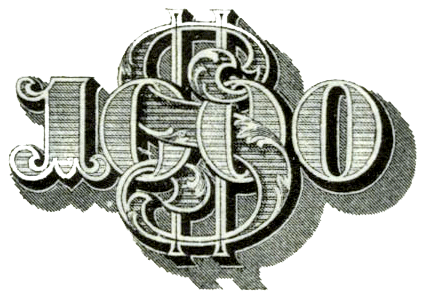What are bonds all about?
Company organizers, incorporators, and executives wanted to retain control of the railroads they started, so they normally tried to avoid selling too much stock and thereby decreasing their own interest. Consequently, they usually needed much more money than they could raise by selling stocks alone. Borrowing was the obvious answer.
Bonds are loans
Banks have always avoided loaning money to risky ventures such as railroads. Consequently, railroads had to turn to individuals for money. In return for loans, companies bonded themselves to investors and promised to repay borrowed money at future dates. Companies formalized their promises with bond certificates.

$1,000 bonds were standard

The earliest known bond created to finance a railroad is a specimen printed for the Petersburg Rail Road Company of Virgnia. It was denominated for $1,000 and we can probably assume that at least some bonds were issued on May 4, 1833. According to OfficialData.org, $1,000 in 1833 would have the approximate spending power of $36,627 in today's (Nov., 2023) dollars.
Since then, railroad companies have issued bonds in denominations ranging from $2 to well over $40,000,000. Companies realize two concepts in selling bonds.
- It is easier to deal with small numbers of large denomination bonds, and
- Average investors prefer small-denomination bonds.
Railroads decided $1,000 bonds were the best balance of sales and operating problems in 1833 and that denomination dominated until paper certificates essentially disappeared in the 1980s. lasted. Almost two-thirds of the collectible bonds currently known are $1,000 bonds. Small-denomination bonds were most popular prior to the 1880s, while $5,000 and larger bonds became popular thereafter.
The lowest denomination currently recorded in the database was a short-term $2 gold note floated by the Ferrocarriles Nacionales de Mexico in 1914. Several companies offered bonds is excess of $1,000,000, but bonds from the New York Central are the easiest to find.

Series
Companies often raised money for various projects by issuing bonds in different series. Denominations, interest rates, and loan periods varied by how desperately companies needed cash and by how difficult it was to find willing investors. In the early years, companies indicated different series by 'First Issue,' 'Second Issue,' and so forth. In later years, they usually named series with letters such as 'Series A' and 'Series B.'
Loan terms
Companies varied the lengths of loans for their own benefits and there is an obvious trend over time. (See also Timeline for related events.)
- Ten-year loan terms were typical for bonds issued before the 1860s.
- Twenty-year terms became popular after the Civil War. By the end of the 1870s, about three-quarters of all bonds were either 20-year or 30-year terms.
- Fifty-year bonds became common throughout the 1880s. During the 1890s, two-thirds of all new bonds carried either 50-year or 100-year terms.
After 1910, trucking began to cut into short-haul railroad shipping. Moreover, passenger traffic was dropping steadily, except for a spike during World War I. Alternative shipping investments grew at the expense of railroad investments. Investors became reluctant to commit cash for long periods to in an industry that seemed to have passed its prime.

By the 1910s, 50-year and 100-year bonds had waned in popularity. Bond terms continued to shorten through the 1920s and 1930s. By the 1940s, terms on railroad bonds were down to thirty and fewer years, There are no hard and fast rules, but most companies used long-term loans for major improvements and short term loans when they needed to make repairs.
The terms on some railroad bonds were so long that they constituted permanent loans. The attractive and common bonds from the West Shore Railroad are prime examples. Initially sold in 1885, West Shore bonds carried terms of 476 years. Presently, the record for long-term bonds goes to the Elmira & Williamsport Railroad. Its $500 bonds from 1862 had 999 year terms!
The shortest terms in the database are those of five years or less. In those cases, companies commonly labeled such certificates as notes instead of bonds. A few 6-month notes are known, but they are all currency-sized certificates and almost certainly circulated as money. Since they functioned as money, they are outside the purview of this project.

Interest rates
Bond interest rates varied among companies and varied through time. Just as today, investors always demanded higher interest rates from riskier companies. In this guide, you will see bond interest rates range from 1.3% to 12%.
Generally, interest rates reflected the financial climate at the times companies needed to borrow money. Low interest rates imply times when inflation was minimal and investors were plentiful. High interest rates suggest times of high inflation and cautious investors.

Of course, other factors affected terms and interest rates as well. For instances, financially solid companies like the Pennsylvania, New York Central, and Baltimore & Ohio attracted huge numbers of investors, so they commonly paid lower interest than companies of lesser reputations. Bonds floated for the development of lines into metropolitan areas usually paid much lower interest over longer terms than those projected to reach into sparsely populated regions.
Examine interest rates by year and you will get a good impression of major movements in finances. For instance, you will see lowest rates on bonds during the confident 1890s, the roaring 1920s and the prosperous 1950s. You will see the highest average interest rates in the years surrounding the depression years of 1857 and 1872 when the only way to attract investors was with crazy high interest rates. (Of course, that doesn't mean companies willing to pay high interest were either successful or even in business a few years later.)